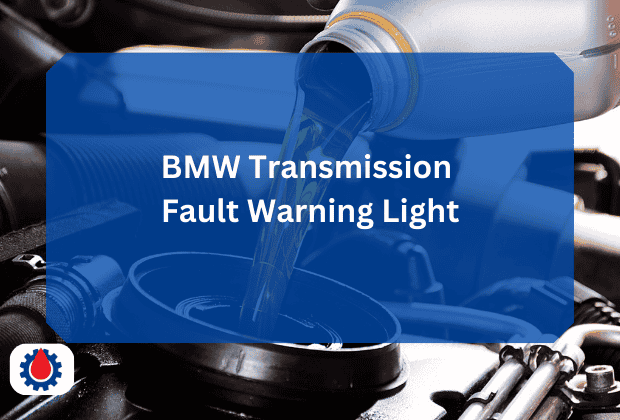In this comprehensive guide, we’ll explore what the BMW transmission fault warning light means, its common causes, symptoms, and the steps you can take to address it.
BMW Transmission Fault Warning Light
1. Low or Contaminated Transmission Fluid
Transmission fluid lubricates and cools the transmission components. Low fluid levels or contaminated fluid (due to dirt, debris, or water) can impair performance, causing the warning light to activate.
2. Faulty Sensors or Solenoids
Modern BMWs rely on sensors and solenoids to monitor and control transmission functions. A malfunctioning sensor, such as the transmission speed sensor, or a faulty solenoid, can disrupt gear shifts and trigger the warning.
3. Software Issues
The transmission control unit (TCU) relies on software to manage gear changes. Glitches or outdated software can cause erroneous fault codes, leading to the warning light.
4. Worn Clutch or Torque Converter
In vehicles with automatic or dual-clutch transmissions, wear and tear on the clutch packs or torque converter can lead to slipping gears or rough shifting, prompting the warning light.
5. Mechanical Failures
Internal transmission components, such as gears or bearings, may wear out over time, especially in high-mileage vehicles. This can result in serious issues that trigger the fault light.
6. Electrical Problems
Faulty wiring, damaged connectors, or issues with the vehicle’s electrical system can interfere with the TCU’s ability to communicate properly, causing the warning light to appear.
Related BMW Service Engine Soon Light(7 Causes + Solutions)
Steps to Take When the Warning Light Appears
If the transmission fault warning light comes on, it’s crucial to act promptly to avoid further damage. Here’s what you should do:
1. Check for Additional Messages: Note any messages displayed on the dashboard, as they may provide specific details about the fault (e.g., “Transmission Malfunction: Drive Moderately”).
2. Assess Drivability: If the car is in limp mode or exhibiting severe symptoms, avoid driving long distances. Pull over safely and assess the situation.
3. Check Transmission Fluid: If you’re comfortable, check the transmission fluid level and condition. Low or discolored fluid may indicate a need for a top-up or flush.
4. Scan for Fault Codes: Use an OBD-II scanner or visit a mechanic to retrieve diagnostic trouble codes (DTCs). These codes can pinpoint the exact issue, such as a faulty solenoid or sensor.
5. Visit a Professional: Transmission issues are complex, and BMWs require specialized knowledge. Take your vehicle to a certified BMW technician or a reputable repair shop with experience in BMW transmissions.
6. Update Software: If the issue is software-related, a BMW dealership can update the TCU software to resolve glitches.
7. Avoid Ignoring the Issue: Continuing to drive with the warning light on can exacerbate the problem, leading to costly repairs or even complete transmission failure.
Related BMW Leaking Coolant but Not Overheating(5 Causes + Solutions)
Symptoms Accompanying the Warning Light
- Rough or Jerky Gear Shifts: The vehicle may struggle to shift gears smoothly, resulting in noticeable jolts or hesitation during acceleration.
- Slipping Gears: The transmission may slip out of gear or fail to engage properly, leading to a loss of power.
- Limp Mode: The car may limit its speed and power output to prevent further damage, often restricting it to a single gear.
- Unusual Noises: Grinding, whining, or clunking sounds from the transmission area can indicate mechanical issues.
- Delayed Engagement: There may be a delay when shifting from park to drive or reverse, or the car may not move immediately when accelerating.
Related P0195 Engine Oil Temperature Sensor(6 Causes + Solutions)
Preventive Maintenance to Avoid Transmission Issues
To minimize the chances of encountering a transmission fault warning light, follow these preventive maintenance tips:
- Regular Fluid Changes: BMW transmissions often require specific fluid types (e.g., ATF for automatics or DCTF for dual-clutch systems). Follow the manufacturer’s recommended service intervals for fluid changes.
- Routine Inspections: Have your transmission inspected during regular maintenance to catch early signs of wear or leaks.
- Drive Responsibly: Avoid aggressive driving habits, such as rapid acceleration or abrupt gear changes, which can stress the transmission.
- Monitor Warning Signs: Pay attention to subtle changes in shifting behavior or unusual noises and address them promptly.
Related Can Low Oil Cause Check Engine Light(Explained)
FAQs
What does it mean when my BMW says transmission fault?
A “Transmission Fault” message on your BMW’s dashboard means the onboard diagnostic system has detected an issue with the transmission, such as low fluid, faulty sensors, software glitches, or mechanical damage. The car may enter limp mode to prevent further issues.
Can I drive a BMW with a transmission fault?
Driving with a transmission fault is not advised. While limp mode may allow short-distance driving, continuing can worsen the issue, leading to costly repairs. Stop and have it inspected by a professional promptly.
How to clear transmission fault on BMW?
To clear a transmission fault, diagnose the issue with an OBD-II scanner, fix the cause (e.g., fluid top-up, sensor repair, or software update), and reset the code with the scanner. Persistent faults require a BMW technician’s expertise.
What does transmission fault warning light mean?
The transmission fault warning light signals a problem with the transmission system, like low fluid, faulty sensors, or mechanical issues. It may trigger limp mode to protect the vehicle, requiring immediate attention.
Can I drive with a transmission fault?
It’s risky to drive with a transmission fault. Limp mode may allow limited driving, but ongoing use can cause severe damage. Get the vehicle checked by a qualified technician as soon as possible.
Final words
The BMW transmission fault warning light is a serious indicator that demands immediate attention. Whether the issue stems from low fluid, a faulty sensor, or a mechanical failure, addressing it quickly can prevent further damage and costly repairs. By understanding the causes, recognizing symptoms, and following proper maintenance practices, BMW owners can keep their vehicles running smoothly and reliably.




